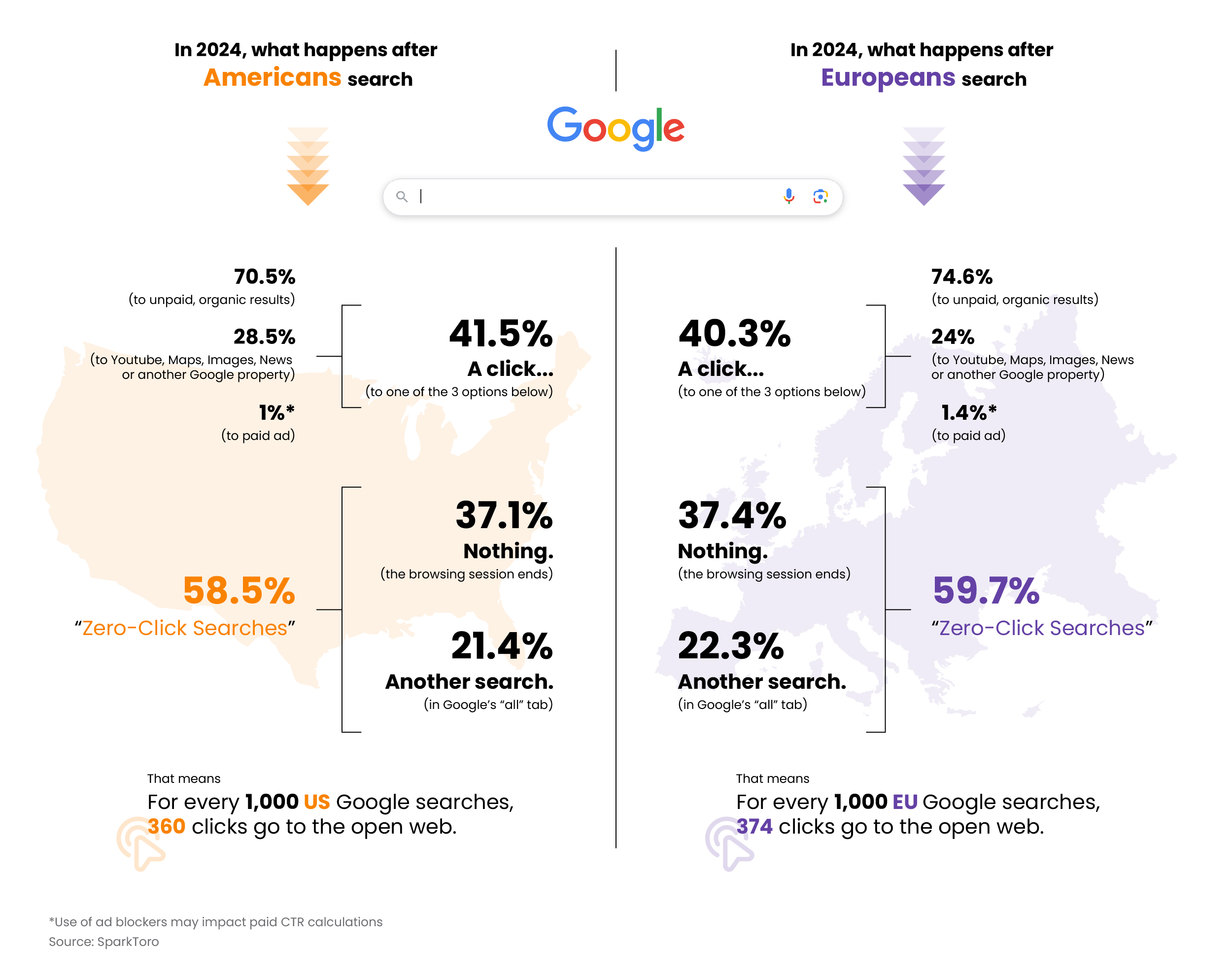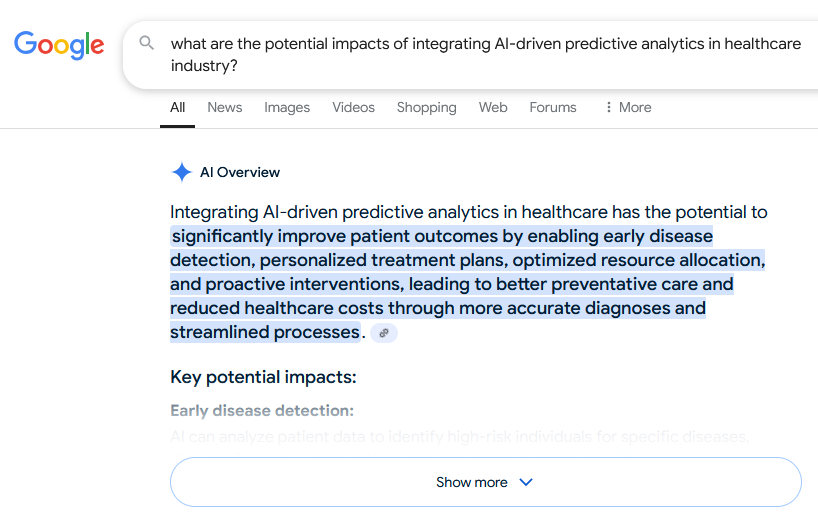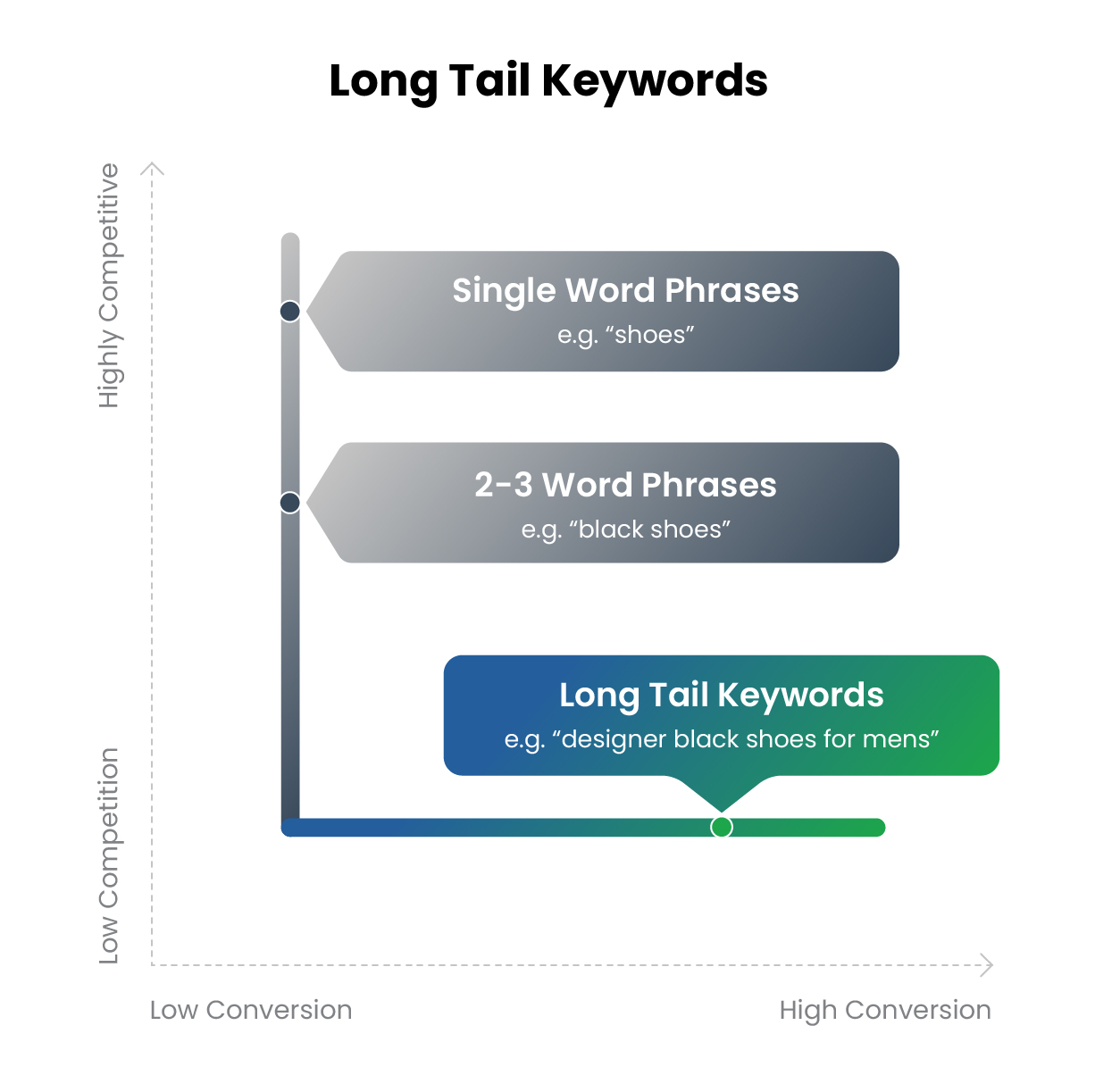Is your website traffic tanking? The rise of zero-click searches is dramatically altering the search landscape, leaving many websites grappling with decreased traffic. A study by SparkToro reveals that nearly 60% of Google searches in the U.S. and EU result in zero clicks. This trend means users often find the information they need directly on the search results page, eliminating the need to click through to any website. With nearly 30% of clicks directed to Google’s properties like YouTube, Google Images, and Google Maps and only about 30% of the total searches going to the open web, many websites are experiencing a sharp decline in organic traffic.

While zero-click searches were initially driven by features like featured snippets and knowledge panels, AI Overviews are becoming a significant contributor, amplifying their impact. To stay competitive, it’s crucial to understand and adapt to these changes, leveraging Google’s ecosystem and enhancing user engagement with high-quality, authoritative content.
While the rise of zero-click searches poses challenges, it also presents opportunities for those willing to adapt. Don’t let your website fade into obscurity while your competitors thrive. Learn to stay ahead of the curve and master the new rules of the digital landscape to safeguard your organic traffic from plummeting.
Google’s AI Overviews, formerly known as Search Generative Experience (SGE), are revolutionizing search technology by delivering personalized SERPs that go beyond traditional listings. By harnessing the power of Google’s Gemini language model and Knowledge Graph, AI Overviews offer precise, relevant information through concise summaries drawn from multiple sources.
This innovation is a game-changer, fundamentally shifting SEO strategies. We can no longer rely solely on traditional keyword optimization. Instead, the focus must shift to creating high-quality, relevant content that aligns with AI-generated answers. This means providing comprehensive, authoritative information that AI Overviews can trust and display.
As AI Overviews continue to integrate deeper into search results, the imperative for businesses and content creators is clear: adapt or be left behind. Those who succeed will produce content that not only ranks well but also serves as a reliable source for AI responses. The future of SEO is here, and it’s AI-driven.

Example of an AI Overview Result
Google’s AI Overviews is a dynamic feature in search results designed to provide users with natural language responses and direct links to webpages for deeper exploration. The appearance of AI Overviews depends on the type of query and the perceived user intent.
1. Selective Display: Google does not always display an AI Overview, especially for queries involving financial recommendations or other sensitive topics. Initially, Google indicated that AI-generated responses would not be available for “Your Money or Your Life” (YMYL) searches, which include financial and legal advice. However, testing has shown that AI Overviews are still provided for many health and medical-related queries, likely due to the confidence provided by Med-PaLM 2, Google’s specialized medical language model.
2. Complex Queries: AI Overviews are more likely to appear for complex queries that traditionally require multiple searches to be fully understood. These are often tasks where users need quick and comprehensive answers. For example, queries like “how to start a business,” “best ways to lose weight,” or “how to improve mental health” might trigger an AI Overview because they require detailed, multi-faceted information.
3. User Intent: The system aims to identify when a generative AI response can be particularly helpful. This typically occurs when users need to quickly understand information tied to a specific task or decision-making process. For instance, if a user searches for “how to set up a home office,” the AI Overview might provide a step-by-step guide directly in the search results.
4. Search Refinement: Studies on zero-click searches indicate that many users perform another search after their initial one, suggesting a need for more precise or additional information. AI Overviews can help bridge this gap by providing more comprehensive answers upfront. This feature is particularly useful for refining searches and ensuring users get the most relevant information without having to sift through multiple links.
In summary, Google’s AI Overviews are designed to appear for queries where comprehensive, quick, and accurate information is essential. By understanding the types of searches that trigger these overviews, businesses can better tailor their content to meet the evolving demands of search engine algorithms and user expectations.

Example of AI Overview triggered for a complex query
With Google’s AI overviews expanding, some may fear a catastrophic decline in organic traffic. However, AI overviews can revolutionize the user’s search experience and catapult visibility for specialist sites.
High-quality content is more critical than ever, as AI overviews thrive on precise data from authoritative sources, channeling traffic to these origins. If your content isn’t up to par, you risk being left in the digital dust.
Website owners must adapt by optimizing content to be AI-overview-friendly, ensuring it is rich in information and meticulously structured. This strategic move will skyrocket their chances of being featured as a source in overviews. Failing to adapt will cause your traffic to plummet.
In the ever-evolving digital search landscape, adaptation is not just necessary—it’s imperative. Embracing advancements in Google’s algorithms can safeguard organic traffic and unlock unprecedented growth opportunities. Quality content and strategic adaptability are the linchpins of success. Ignore this shift at your peril.
To dominate traffic through AI overviews, craft meticulously documented, irresistibly digestible content that catapults your site to authority status.
By leveraging crystal-clear headers, structured data, and seamlessly interlinking related topics, websites can supercharge their content for AI-driven summaries, ensuring they become the go-to high-quality sources in AI overviews.

Sources listed on an AI Overview Result
Targeting long-tail keywords can revolutionize a site’s chances of dominating AI-driven overviews. These phrases, typically three to five words long, deliver an exact match for specific search queries, drawing in highly targeted traffic.
Long-tail keywords make up about 70% of all web searches.
Incorporating long-tail keywords ensures content remains laser-focused on niche audiences, catapulting its ranking in search engine results. By aligning content with user intent, site owners can captivate Google’s AI, skyrocketing visibility within specialized segments. This strategy not only turbocharges organic traffic but also cements the site as an authoritative resource, driving relentless user engagement.

High-quality content is the cornerstone of optimizing for Google’s AI overviews. This means creating valuable, engaging, and informative material that resonates with the audience.
1. Conduct Thorough Research: Ensure that all information is accurate and up-to-date.
2. Use Clear and Concise Language: Make complex topics easy to understand without oversimplifying.
3. Incorporate Visuals: Use images, infographics, and videos to enhance and clarify the content.
4. Implement Internal Linking: Connect various pieces of content on the website to keep users engaged.
5. Optimize for Readability: Use headings, bullet points, and short paragraphs to make content digestible.
A well-defined structure significantly enhances the chances of ranking on AI Overviews by organizing content with clear headings and subheadings. Logical segments encourage deep engagement, promoting a rewarding experience for users. Hierarchies streamline navigation and improve SEO, making it easier for Google’s AI to understand and index the content effectively.
This meticulous organization not only boosts site rankings but also reinforces authority and attracts new audiences. By presenting information in a structured and accessible manner, the content becomes more likely to be featured in AI Overviews, ensuring it reaches a broader audience and achieves higher visibility in search results.

Structured data is instrumental in optimizing Google’s AI overviews. By incorporating structured data, one enables search engines to understand the content better.
Properly formatted structured data can significantly enhance its visibility in search results, as schema markup can highlight critical information.

Example of use of Structured Data
Achieving comprehensive coverage ensures that all relevant aspects of a topic are thoroughly addressed and presented to the audience.
1. Identify Core Topics: Determine the primary themes and subtopics related to the main subject.
2. Conduct Deep Research: Utilize authoritative sources to gather detailed and accurate information.
3. Organize Content Logically: Present information in a coherent structure that flows naturally.
4. Provide Supporting Details: Include data, examples, and expert opinions to strengthen the content.
This holistic approach fosters credibility and improves the chances of appearing in Google’s AI overviews.
Updating content regularly enhances the chances of ranking in Google’s AI Overviews. Google’s AI prioritizes relevant and up-to-date content, signaling its value to users. Fresh content, including updated statistics and recent developments, aligns with current trends and user queries, boosting engagement.
Frequent updates also capture new keywords and search intents, keeping content competitive in search rankings. By consistently providing fresh, relevant content, websites can improve visibility and authority, increasing their chances of being featured in Google’s AI Overviews.
Use a conversational tone to optimize for Google’s AI overviews. This style engages both AI and human readers, making complex information more digestible.
Friendly content enhances user experience and boosts metrics like clicks and on-page time, positively impacting search rankings. Simple, direct language, questions, and informal phrases align with AI preferences.
The aim is to create human-like dialogues, fostering connection and trust while maintaining professionalism.
Google’s AI Overviews, powered by the cutting-edge Gemini language model and Google’s Knowledge Graph, are revolutionizing the search landscape by delivering razor-sharp results synthesized from a multitude of sources. This groundbreaking feature targets top-tier, relevant content and selectively appears for the most intricate queries. While some may fear a decline in organic traffic, AI Overviews presents a game-changing opportunity to elevate user experience and drive visibility. To thrive in this new era, you need exceptional, meticulously structured content that AI Overviews favor. Position2 can help you transform your SEO strategy and safeguard your organic traffic. Ready to dominate AI Overviews and supercharge your traffic? Adapt now, and watch your website rise to the top!
What are zero-click searches, and how do they impact website traffic?
Zero-click searches occur when users find answers directly on the search engine results page without clicking through to a website. These searches, driven by features like AI Overviews and featured snippets, reduce traditional website traffic while increasing competition for visibility on SERPs.
How do AI Overviews influence the rise of zero-click searches?
AI Overviews provide users with concise, accurate answers sourced from multiple websites, fulfilling their intent directly on the SERP. This feature significantly contributes to zero-click searches, reducing the need for users to visit individual websites for information.
How can businesses optimize their content for AI Overviews?
Businesses can optimize by creating high-quality, authoritative content with a clear structure, including headings, bullet points, and schema markup. Focusing on user intent, long-tail keywords, and comprehensive topic coverage ensures their content is trusted and featured in AI Overviews.
What metrics should marketers track to measure the impact of AI Overviews on organic performance?
Marketers should monitor impressions, click-through rates (CTR), and average position. Analyzing zero-click performance in Google Search Console and assessing branded search visibility is also key. Additionally, marketers can use tools like SEMrush to measure the number of keywords for which their website is ranking in AI Overviews.
How can AI Overviews be integrated into a broader content marketing strategy?
AI Overviews can position your brand as an authority by focusing on high-quality, user-focused content that aligns with search intent. Use insights from AI Overviews to refine your content topics, address gaps, and create supporting assets like blogs to reinforce your visibility across search and other platforms.